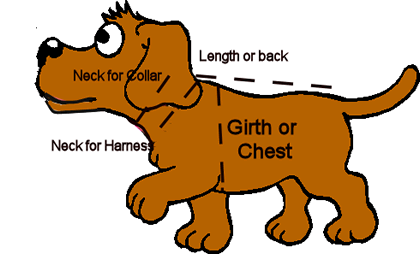Before we had a dog supply shop we always bought the wrong size everything for our dogs. But dog measurements are easy to get right. With just a few minutes of preparation, you’ll always get it right!
Measure twice, don’t cut at all
There are just a few dog measurements that you need. A tape measure designed for sewing is the best tool to use, but if you don’t have one, don’t worry. You can use any piece of string or yarn, mark it, and measure it against either a yard stick or retractable metal measure.
Chest or girth is the most important measurement for harnesses. The key is to measure the dog all the way around, just behind the front legs. This is usually the deepest part of the chest. And you do need to get the broadest/deepest part of the chest.
You may also want to get the dog’s neck measurement for harnesses as well as collars, although it may be different. For a harness, you’ll need the neck measurement where the neck meets the shoulders, down by the collar bone. Collars require a measurement at the other end of the neck, up where it meets the jaw bone.
With some dogs, there won’t be a significant difference, especially if your dog doesn’t have much of a neck, like Hope’s French Bulldog Torque. For others, it may be the difference between a collar slipping off over the dog’s head, or not.
Dog clothes are different
For clothes the measurements you need are different. Most dog clothes are sized by the length of the dog’s back. Measure from the nape of the neck to the base of the tail. Don’t include either the neck or tail in the measurement.
Additionally, and just for the sake of argument, we’d recommend that owners of boy dogs measure underneath, as well. The length of the dog’s chest/tummy to the start of the “naughty bits.” Too many times those of us with boy dogs have done extra laundry because we didn’t pay close enough attention to this crucial measurement.
Boots
We’ve seen lots of people assume that you need to either try dog boots on “in person,” or trace the whole paw and bring that to the shop. It’s actually easier than you think to measure dogs’ paws for boots.
Place a piece of paper on the floor and have your dog step on it. Quickly mark either side of the paw. Just the sides, you don’t need front and back. It’s the width of the paw that matters in dog boots.
Many dogs’ front paws are significantly wider than the back paws. If this is true for your dog, measure one of each so you’ll know if you need two different sizes of the Pawz boots.
Small dog measurements matter
Because there are no size standards in the pet industry, you can never be sure your dog wears a particular size. It depends on the manufacturer – all makers create their own size charts. Many of the producers we deal with for our shop only make gear for small dogs, so a 20 lb. dog could need a size “Large.” Other manufacturers, who make things for all size dogs, would have an “Small” fitting that same 20 lb. dog. That’s why having the measurements matters.
Keep them handy
Now that you have all these statistics about your dog, what do you do with them?
You’ll have your dog measurements handy at all times with this tip: Create a “contact” for your dog in your smart phone. In the notes section, record all of your dog’s measurements! You’ll always have them with you!















